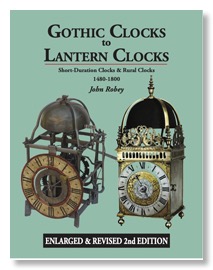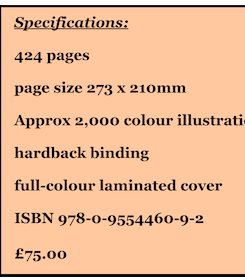

BUY THIS BOOK
Gothic Clocks to Lantern Clocks
Short Duration Clocks & Rural Clocks 1480-1800
by John Robey
ENLARGED & REVISED 2nd EDITION
The earliest mechanical clocks were installed in European churches and other public buildings, often with astronomical displays. By the fourteenth century small clocks for domestic use became more widespread, initially as simple timepieces or alarms. These developed into elaborate iron based on Gothic styles of architecture, with painted iron dials, and usually striking the hours on a bell, or even also the quarter hours. These clocks were bought by the wealthy throughout Europe, including Britain,
By the start of the seventeenth-century English clockmakers developed the lantern clock, made mostly of brass with engraved dials, to replace Continental iron clocks, which had become old fashioned and unreliable. The focus of clockmaking then shifted from Germany to England. Iron clocks were still made, especially for the less well-to-do, and continued as rural clocks until the early nineteenth century.
While Gothic clocks and early lantern clocks are widely studied and collected, less attention has been paid to later rural and short duration clocks, with little information in print. Gothic Clocks to Lantern Clocks remedies
this by discussing a wide range of clocks, many of them being unique examples or having unusual and interesting features, many of which are quite different to those of English clocks. Since they are mostly unsigned, regional technical characteristics have to be used to establish their origins, and there is an emphasis on constructional and technical features, while not neglecting the design of their dials.
This enlarged and revised 2nd edition has an introductory chapter discusses the three main types of Gothic clock, details and variations of strip frames and posted frames, wheels, hour and quarter striking, bells and dials. Five chapters describe and illustrate twenty-six Germanic clocks, thirteen Italian clocks, fourteen French and Flemish clocks, twenty-two English clocks and four Swedish clocks. Each has up to thirty colour illustrations, as well as wheel counts and dimensions. Restorations, reproductions, replicas and fakes are also discussed, followed by eight appendixes, an annotated bibliography and an index.
With almost 2,000 full-colour illustrations, most of them taken specially for this book, and with much technical and other information never before published, this book sets a new standard in horological publishing.
Contents
Chapter 1 Introduction to Short-Duration Clocks & Rural Clocks
Chapter 2 Germanic Clocks
Chapter 3 Italian Iron Clocks & Lantern Clocks
Chapter 4 Iron Clocks & Lantern Clocks from France
& the Low Countries
Chapter 5 English Lantern Clocks & Thirty-Hour Clocks
Chapter 6 Swedish Iron Clocks
Chapter 7 Modernizations, Restorations, Reproductions & Fakes
Appendix A Early Horological Illustrations
Appendix B The Invention of Warned Striking
Appendix Ba Alleged Precursor English Lantern Clocks
Appendix Bb Hybrid Iron & Brass English Lantern Clocks
Appendix C English Lantern Clocks with an Original Balance
Appendix D An Italian Treatise on Clocks, 1665
Appendix E Going Train & Striking Train Calculations
Appendix F Faces of Time
Annotated Bibliography
Index
The author
John Robey has written numerous articles in Antiquarian Horology, Horological Journal and Clocks magazine on a wide range of horological subjects, and is also the author of The Longcase Clock Reference Book. For his contributions to horological research, writing and publishing he was awarded the British Horological Institute’s Barrett Silver Medal in 2007 and an HonFBHI in 2022.
© 2018 John Robey Contact Me
